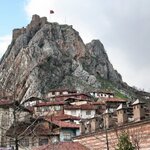Archaeology

Think you're extreme? 12,000 years ago Ice Age Humans lived and worked at an altitude of almost 15,000 feet, high in the Peruvian Andes.
The sites in the Pucuncho Basin, located in the Southern Peruvian Andes, are the highest-altitude Pleistocene archaeological sites found to-date. The primary site, Cuncaicha is a rock shelter at 4,480 meters above sea level, with a stone-tool workshop below it. There is also a Pucuncho workshop site where stone tools were made at 4,355 meters above sea level.
Climatic conditions in both sites are harsh, with factors including low-oxygen, extreme cold and…

An international team has retrieved antiquities including tableware, ship components, and a giant bronze spear that would have belonged to a life-sized warrior statue from an ancient Greek ship that sank more than 2,000 years ago off the remote island of Antikythera.
The Antikythera wreck was first discovered in 1900 by sponge divers who were blown off course by a storm. They subsequently recovered a haul of ancient treasure including bronze and marble statues, jewelry, furniture, luxury glassware, and the surprisingly complex Antikythera Mechanism. But they were forced to end their mission…

A close up of one of the hand stencils found in the prehistoric caves in Indonesia. Credit: Kinez Riza, Author provided
By Paul S.C.Taçon, Griffith University; Adam Brumm, Griffith University, and Maxime Aubert, Griffith University
Rock art dated to a minimum age of almost 40,000 years has been discovered in the Maros region of southern Sulawesi, Indonesia. This is an incredible result, published in Nature today, because one of the biggest challenges in rock art research is dating.
Consequently, every time we get dates for rock art, wherever from and no matter how old or young, it is…

By Joel N. Shurkin, Inside Science -- The enemy of archeology everywhere is salt. It destroys buildings, disassembles art works, and can turn ancient pottery into piles of dust.
How salt lays waste to these artifacts is well known, but scientists in Switzerland have monitored the process in a laboratory. Their observations could help preserve the buildings, art, and treasured relics of humanity.
The salts in question are not just sodium chloride, the salt on your dining room table or in the sea, but substances such as fluorides, sulfates, and acetates -- substances formed when acids and bases…

It's not a surprise that as we get ready for Halloween season, stories will start to appear that relate to the macabre. And nothing is more macabre to modern minds than the tale of Vlad Dracul, who was on the front lines battling the Muslims in Eastern Europe and reputedly impaled 20,000 bodies as a warning to them.
It seemed to have worked, at least in that famous instance. You can imagine a sane Ottoman general seeing that spectacle and thinking 'Do we want to own a country where people have not set a guy like that on fire? The personnel headaches would be tremendous.'
Why would he do that…
Artifacts from a 325,000-year-old site in Armenia finds that human technological innovation occurred intermittently throughout the Old World, rather than spreading from a single point of origin (usually hypothesized as Africa), as previously thought.
A new paper in Science detailed thousands of stone artifacts retrieved from Nor Geghi 1, a unique site preserved between two lava flows dated to 200,000–400,000 years ago. Layers of floodplain sediments and an ancient soil found between these lava flows contain the archaeological material.
The dating of volcanic ash found within the…

Metoera. Credit:Panos Photographia/Flickr
By Steve Ellen, Monash University
Everyday life is full of mini-ethical moments. Do you own up to being under charged? Do you push in when the traffic is heavy and you’re running late? Do you hassle your kid’s teacher to get little Jimmie or Jane an advantage?
Most of us do our best, but various emotions, motives, and practicalities act to push us to our limits. Sometimes our limits are breached – mine were on a recent tour in Greece.
I was in Athens and I had a few days spare, so on the spur of the moment decided on a tour to Meteora. Meteora is one…

A 1,500 year old papyrus fragment contains some of the earliest documented references to the Last Supper and ‘manna from heaven’.
Dr. Roberta Mazza of the University of Manchester came across the Greek ‘amulet’ while working on thousands of fragments of unpublished historical documents that are kept in the library’s vaults. At 1,500 years old, it is the earliest surviving document to use the Christian Eucharist liturgy - which outlines the Last Supper - as a protective charm.
The charm casts new light on early Christianity, just 300 years after the Roman emperor Constantine converted to the…

Previously unknown archaeological monuments have been discovered around Stonehenge as part of a digital mapping project that will transform our knowledge of this iconic landscape – including remarkable new findings on the world's largest 'super henge', Durrington Walls.
Remote sensing techniques and geophysical surveys have discovered hundreds of new features which now form part of the most detailed archaeological digital map of the Stonehenge landscape ever produced. The startling results of the survey, unveiled in full at the British Science Festival, include 17 previously unknown ritual…

South of Copenhagen, Danish archaeologists have done something that has not happened in over 60 years - they have found a previously undiscovered Viking fortress.
It will be a surprise to most that Vikings built fortresses at all - they were the people that caused everyone else to build fortresses, who was dangerous enough to raid them? Their fellow berserkers and pirates, of course.
Using new, precise laser measurements of the landscape out curator Nanna Holm of
Nanna Holm of The Danish Castle Centre
on the trail of the fortress. An almost invisible rise in the field was proved by new…